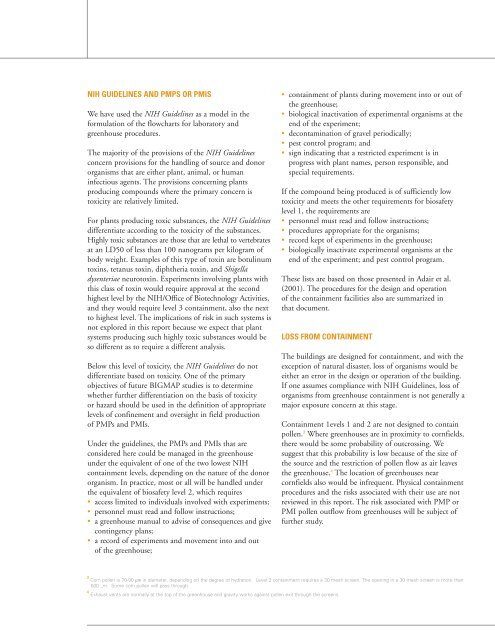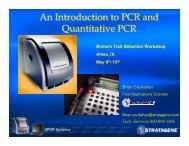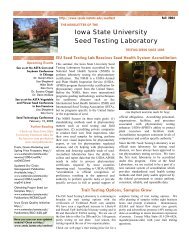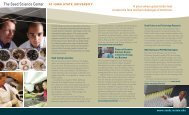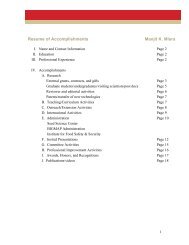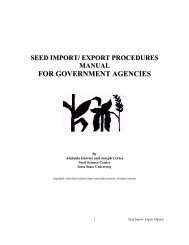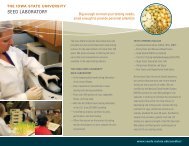Confined Production Processes for Non-Food Corn - Seed Science ...
Confined Production Processes for Non-Food Corn - Seed Science ...
Confined Production Processes for Non-Food Corn - Seed Science ...
You also want an ePaper? Increase the reach of your titles
YUMPU automatically turns print PDFs into web optimized ePapers that Google loves.
NIH GUIDELINES AND PMPS OR PMISWe have used the NIH Guidelines as a model in the<strong>for</strong>mulation of the flowcharts <strong>for</strong> laboratory andgreenhouse procedures.The majority of the provisions of the NIH Guidelinesconcern provisions <strong>for</strong> the handling of source and donororganisms that are either plant, animal, or humaninfectious agents. The provisions concerning plantsproducing compounds where the primary concern istoxicity are relatively limited.For plants producing toxic substances, the NIH Guidelinesdifferentiate according to the toxicity of the substances.Highly toxic substances are those that are lethal to vertebratesat an LD50 of less than 100 nanograms per kilogram ofbody weight. Examples of this type of toxin are botulinumtoxins, tetanus toxin, diphtheria toxin, and Shigelladysenteriae neurotoxin. Experiments involving plants withthis class of toxin would require approval at the secondhighest level by the NIH/Office of Biotechnology Activities,and they would require level 3 containment, also the nextto highest level. The implications of risk in such systems isnot explored in this report because we expect that plantsystems producing such highly toxic substances would beso different as to require a different analysis.Below this level of toxicity, the NIH Guidelines do notdifferentiate based on toxicity. One of the primaryobjectives of future BIGMAP studies is to determinewhether further differentiation on the basis of toxicityor hazard should be used in the definition of appropriatelevels of confinement and oversight in field productionof PMPs and PMIs.Under the guidelines, the PMPs and PMIs that areconsidered here could be managed in the greenhouseunder the equivalent of one of the two lowest NIHcontainment levels, depending on the nature of the donororganism. In practice, most or all will be handled underthe equivalent of biosafety level 2, which requires• access limited to individuals involved with experiments;• personnel must read and follow instructions;• a greenhouse manual to advise of consequences and givecontingency plans;• a record of experiments and movement into and outof the greenhouse;• containment of plants during movement into or out ofthe greenhouse;• biological inactivation of experimental organisms at theend of the experiment;• decontamination of gravel periodically;• pest control program; and• sign indicating that a restricted experiment is inprogress with plant names, person responsible, andspecial requirements.If the compound being produced is of sufficiently lowtoxicity and meets the other requirements <strong>for</strong> biosafetylevel 1, the requirements are• personnel must read and follow instructions;• procedures appropriate <strong>for</strong> the organisms;• record kept of experiments in the greenhouse;• biologically inactivate experimental organisms at theend of the experiment; and pest control program.These lists are based on those presented in Adair et al.(2001). The procedures <strong>for</strong> the design and operationof the containment facilities also are summarized inthat document.LOSS FROM CONTAINMENTThe buildings are designed <strong>for</strong> containment, and with theexception of natural disaster, loss of organisms would beeither an error in the design or operation of the building.If one assumes compliance with NIH Guidelines, loss o<strong>for</strong>ganisms from greenhouse containment is not generally amajor exposure concern at this stage.Containment 1evels 1 and 2 are not designed to containpollen. 3 Where greenhouses are in proximity to cornfields,there would be some probability of outcrossing. Wesuggest that this probability is low because of the size ofthe source and the restriction of pollen flow as air leavesthe greenhouse. 4 The location of greenhouses nearcornfields also would be infrequent. Physical containmentprocedures and the risks associated with their use are notreviewed in this report. The risk associated with PMP orPMI pollen outflow from greenhouses will be subject offurther study.3 <strong>Corn</strong> pollen is 70-90 µm in diameter, depending on the degree of hydration. Level 2 containment requires a 30 mesh screen. The opening in a 30 mesh screen is more than500 _m. Some corn pollen will pass through.4 Exhaust vents are normally at the top of the greenhouse and gravity works against pollen exit through the screens.


